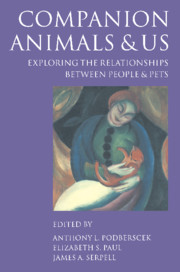Book contents
17 - Rethinking bestiality: towards a concept of interspecies sexual assault
from Part IV - Welfare and ethics
Summary
INTRODUCTION
In this chapter I seek to contribute to an as-yet-unconstituted sociology of animal abuse (Beirne, 1995), though my specific focus derives less from overtly theoretical labours directed to this end than from the practical needs of pedagogy. In trying to develop an undergraduate course on the sociology of animal abuse, I was immediately confronted with conveying to my students adequate responses to the deceptively simple question ‘What is animal abuse?’. Class time devoted to the spectre of such dramatic and well-publicized practices as factory farming, laboratory experimentation, trapping, circuses, etc., would, I believed, tend to stimulate among students a visceral reaction rather than the desired goal of sustained enquiry about the nature of animal abuse.
It happened that, in casting a wide net for some heuristic device that would enable me to examine animal abuse in a pedagogic context, I stumbled upon a would-be erotic video provocatively entitled Barnyard Love. This crudely produced, undated German film graphically depicts numerous human and other animals engaged in acts of interspecies sexual relations. Among these are human males, who engage in sexual intercourse with cows and hens and, more often – given that heterosexual males are presumed to be the film's chief audience – human females, who have sexual intercourse with dogs, insert eels into their vaginas and perform fellatio on dogs and horses.
Even from my amateurish perspective and despite the risks of anthropomorphism, I noticed how immensely varied were the filmed reactions of the different non-human animals (henceforth ‘animals’) to attempted sexual union with, and initiated by, humans. At one extreme, the dogs in Barnyard Love who were engaged in sexual activities with women seemed energetically to enjoy such human attention. To me, at least, it did not seem possible that such canine enthusiasm could be feigned by off-camera training designed to suppress more genuine emotions of grief and pain. At the opposite extreme, some animals, such as eels and hens, were obviously unwilling recipients of human sexual advances. None of my students would have much trouble, I thought, in identifying as animal abuse the case of one unfortunate hen who died as a terrifying consequence of enforced sexual intercourse with a human male.
- Type
- Chapter
- Information
- Companion Animals and UsExploring the relationships between people and pets, pp. 313 - 331Publisher: Cambridge University PressPrint publication year: 2000



